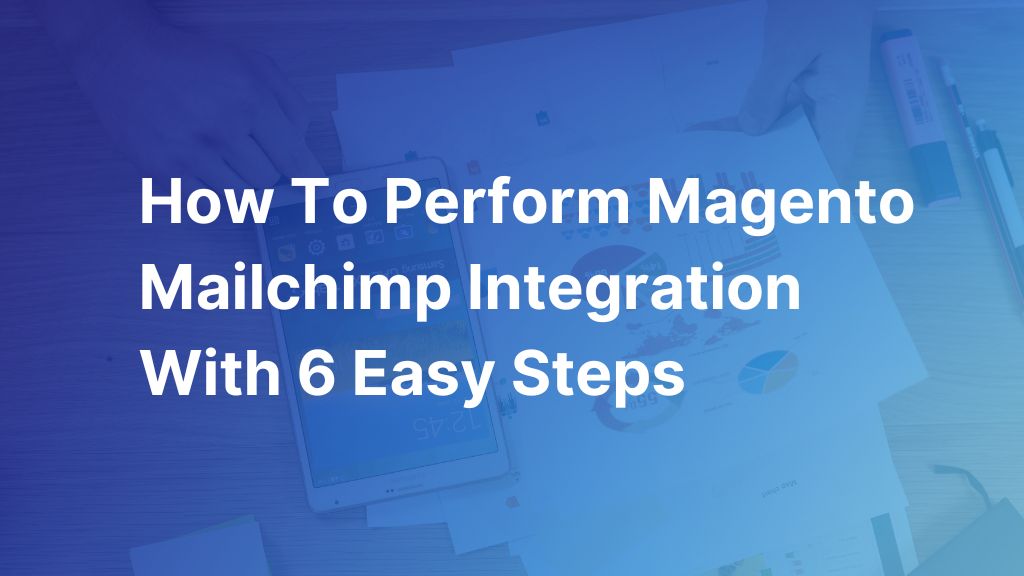Mailchimp and Magento (Adobe Commerce) are the leading eCommerce platforms in the market. Mailchimp, a renowned email marketing service, and Magento, a popular eCommerce platform, have the potential to revolutionize the eCommerce landscape.
When using Magento Mailchimp integration, your business can utilize the maximum strengths of each platform and boost sales effectively. Especially as the eCommerce industry continues to evolve, businesses that take advantage of the integration of platforms will adapt to changing markets and have a chance to be competitive compared to competitors. This integration opens up possibilities for more advanced marketing strategies, improved customer retention, and increased revenue growth in the future.
In this article below, BSS Commerce Magento will provide details about the step-by-step guides to Magento Mailchimp integration, as well as the top benefits of connecting them. Now, let’s scroll down to learn more.
Magento and Mailchimp: At a Glance
Table of Contents
Before finding out the benefits and complete guides for Magento and Mailchimp integration, explore the brief explanations of Magento (Adobe Commerce) and Mailchimp to make sure that you understand the essence of each platform and how they work for an online business.
Short Introduction to Magento (Adobe Commerce)
Magento (Adobe Commerce) is best for: Adobe Commerce is tailor-made to meet the requirements of larger businesses with solid financial standing.

Adobe Commerce, formerly known as Magento Commerce, is a versatile and scalable commerce platform that enables you to create unique and personalized B2B and B2C experiences, regardless of the number of brands you possess.
Magento (Adobe Commerce) offers a solid base for eCommerce capabilities, enabling businesses to effortlessly and swiftly launch customized commerce experiences while ensuring security and without the need to start from the beginning. It is an advanced platform that fosters innovation, providing pre-built modular services that can be rapidly implemented and utilized. In addition, it facilitates the development and integration of secure and scalable applications that enhance the platform’s native functionality and seamlessly integrate with external solutions within a serverless environment that complies with PCI standards.
Short Introduction to Mailchimp
Mailchimp is best for: Mailchimp is an excellent option for businesses that intend to incorporate email marketing into their fundamental marketing strategy and desire a platform that can expand and become more powerful.
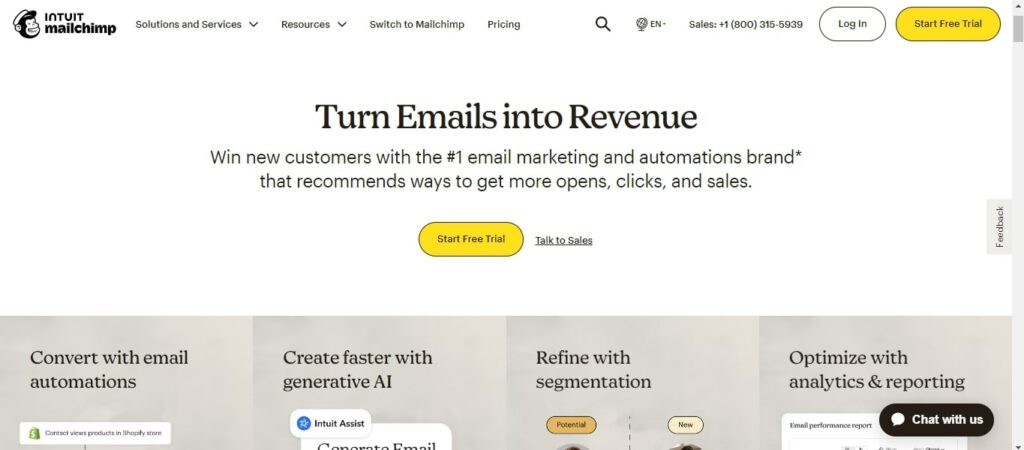
Mailchimp is the comprehensive automation marketing and email platform that helps you manage and communicate with your clients, customers, and other parties. Mailchimp is consistently ranked as one of the top email marketing platforms thanks to its user-friendly software and is highly regarded for its ability to create automated email marketing campaigns effortlessly.
In addition, it stands out as one of the most cost-effective options available, offering a free forever plan for one user with up to 1,000 email sends per month. For those with higher email volumes, Mailchimp offers competitively priced paid plans starting at just $13 per month for up to 5,000 monthly email sends.
The Final Verdict: It can be claimed that Magento and Mailchimp are great platforms with their strengths and various advanced features. By combining Magento’s robust eCommerce capabilities with Mailchimp’s effective email marketing features, businesses can effectively manage their online presence. In addition, this integration opens doors to more advanced marketing strategies, improved customer retention, and increased revenue growth. It presents an exciting prospect for businesses looking to optimize their eCommerce operations and achieve greater success in the digital marketplace.
To gain a deeper understanding of the benefits of Magento Mailchimp integration, let’s explore the details in the section below.
Magento Mailchimp Integration: What advantages does the integration of these two platforms offer?
Effortless Campaign Design and Launch
Creating a personalized email marketing campaign on Mailchimp is a breeze, even if you’re not a tech whiz. You don’t need to know any coding languages like HTML, CSS, PHP, or JavaScript. Mailchimp’s user-friendly web builder lets you design your campaign without any coding skills.
You can pick and choose from different features and ready-made layouts for various types of emails. Plus, you have a wide selection of themes for your emails, and you don’t need to do any backend coding.
Moreover, Mailchimp offers different themes for different purposes and events. You can find a variety of built-in themes for emails, whether they’re for holidays, newsletters, notifications, or subscription alerts. These features make it easy for you to create custom email templates, even if you don’t have a team of developers.
So, when you send emails to your Magento customers, they’ll be well-structured, appealing, and personalized just for them. It’s all about making your emails stand out and connect with your audience.
Custom templates with unique coding
You can create your own unique Mailchimp template using your HTML code. Mailchimp’s custom builder makes this easy. All you have to do is paste your code and run it to create your design. You can also upload zip files containing the HTML code of your custom template or import it directly from a website. Then, you can turn it into a new design on Mailchimp.
On the other hand, you can use this template in your Magento store too, thanks to Magento Integration Services. It’s a great way to keep your branding consistent across different platforms.
Email Automation
Mailchimp’s success as an email marketing platform is largely due to its automation features. These features map out the customer lifecycle, improving satisfaction levels. Automation isn’t just for marketing emails; it can be used for transactional emails, social media, ads, coupons, and postcards too.
The goal is to customize the user experience and target marketing to meet business needs without needing a large team. You can target specific customer segments, like sending reminders to users with abandoned carts or birthday discounts.
This means you can send relevant emails to specific groups without manually writing and sending each one. This is especially useful for Magento store owners with large customer bases and contact lists, helping to reduce operational costs by limiting the workforce, reducing workload, and increasing efficiency.
Customer Journey Builder
Mailchimp’s customer journey builder is a cool new feature. It’s a tool that helps you create a complete customer experience across different channels. This means Magento store owners can track user behaviors and send the right messages at the right time.
The journey builder works like a sales funnel. It determines the flow for different customer segments based on triggers and how customers responded to past emails. The journey isn’t a straight line; you can use “if/else” statements to map out a full journey for each customer segment. You can also add or remove tags to enhance the journey. In general, with using the journey builder for your marketing campaigns, you can boost conversion rates, reduce email spam, and keep more customers.
Preview Emails Before Sending
Previewing an email before sending it out is crucial to ensuring accuracy and avoiding any potential issues. HTML can be complex, and different email clients may display the same code differently. With Mailchimp, Magento store owners have the ability to preview their emails before sending them. This platform offers a preview option that supports multiple different systems and allows you to experiment with and determine the most effective email messengers for your target market by testing different layouts and designs.
In addition, the preview feature provides a clear understanding of how the email will appear when opened, without actually sending it to contacts. This ensures that your campaign is not compromised and delivers a seamless experience to your Magento store owner recipients.
Implement Geo Targeting in Campaigns
Magento stores don’t necessarily target all customers. Instead, they may focus on specific market segments in certain cities, provinces, or countries. This crucial aspect is often overlooked by other email platforms when devising email marketing strategies. Mailchimp, however, caters to this need. It allows Magento store owners to segment their marketing geographically based on the customer’s location.
Generate Insights
Marketing products in a Magento store is a continuous process that allows store owners to learn from past campaigns and improve future ones. This crucial data helps them assess the success and failure of their marketing efforts systematically. Mailchimp supports this process by providing detailed reports of the campaigns, complete with charts and graphs for easy understanding. These insights can help gauge the campaign’s performance on social media and against competitors. Interestingly, you don’t need to be an email marketing expert to use this feedback constructively, as the software provides all the necessary information.
Monitor Store Performance
Mailchimp reports provide Magento store owners with the ability to track the performance and activity of their store. Through utilizing these reports, store owners can easily identify which customers purchased specific items from their Magento store following the opening of a campaign.
Apply Artificial Intelligence
Mailchimp uses an AI simulation to analyze billions of data points and offer intelligent features. These features optimize content to reach the right audience at the right time. For instance, Mailchimp can analyze data and intelligently suggest product blocks based on customers’ personalized preferences or all-time favorite products. This functionality also enables the creation of highly personalized emails for customers, eliminating the need to start from scratch.
Surveys
Surveys play a vital role in email marketing, specifically as follow-up emails that seek customer feedback. With Mailchimp, you can leverage a comprehensive survey to gather insights from your Magento store customers. This feedback can then be utilized to make data-driven price predictions, generate innovative ideas, and explore the product-market fits.
Create Engaging Landing Pages
The primary goal of marketing emails is to engage recipients and direct them to a landing page, thereby converting leads into customers and boosting sales. Mailchimp enables Magento store owners to create custom landing pages tailored to their products. This allows for effective lead generation, product promotion, growth listing, and payment acceptance.
In addition, the Magento Mailchimp integration can greatly enhance and sustain your business. The features discussed facilitate the creation of highly effective marketing campaigns with a very high return on investment, considering that the Magento integration services are implemented by a professional Magento Web development company.
After discovering the benefits of Mailchimp Magento 2 integration, refer to the complete guides to connecting these two platforms to each other with easy steps in the next section.
Magento Mailchimp Integration: The Complete Guide with Easy Steps
Here are some notable points before Magento 2 Mailchimp integration:
1. Please visit the Magento listing in your account to see the eCommerce features supported by this integration.
2. This integration is designed to work with API version 3.0.
3. If you are currently using MageMonkey, please uninstall it before utilizing Mailchimp for Magento.
Before You Start
Before you start this process, there are some important points to keep in mind.
1. This process requires expertise in editing Magento’s root directory. If you need assistance, reach out to your Magento expert or developer.
2. Please note that Mailchimp for Magento does not support custom, bundled, grouped, or gift card product types.
3. It is highly recommended to back up your server files and database before installing this integration. However, this guide suggests installing it on a test server first..
4. Mailchimp for Magento is compatible with the following versions of Magento: CE v1.7.x, CE v1.8.x, CE v1.9.x, CE v2.3.x, EE v1.10.x, EE v1.11.x, EE v1.12.x, EE v1.13.x, EE v1.14.x, and EE v2.3.x.
5. Please note that the Abandoned Cart automation feature is only compatible with Mailchimp for Magento version 1.06 or later.
6. The Order Notifications automation feature is only compatible with Mailchimp for Magento version 1.1.5 or later. If you choose to use this automation, make sure to disable your Sales Emails in Magento to avoid sending duplicate emails to your customers.
7. At this time, Mailchimp for Magento does not support product retargeting.
8. If you want to use Mandrill for Magento, please install or update to version 1.1.1 or later of Mailchimp for Magento.
9. Version 1.1.6 of Mailchimp for Magento introduces support for multiple stores.
10. If you are working with Adobe Commerce, formerly known as Magento 2, please check out the Connect or Disconnect Mailchimp for Adobe Commerce feature.
Step 1. Access and Download the Mailchimp Extension for Magento
To begin, you will need to download the Mailchimp for Magento file extension from the Ebizmarts marketplace (This Magento 2 Mailchimp extension is totally free).
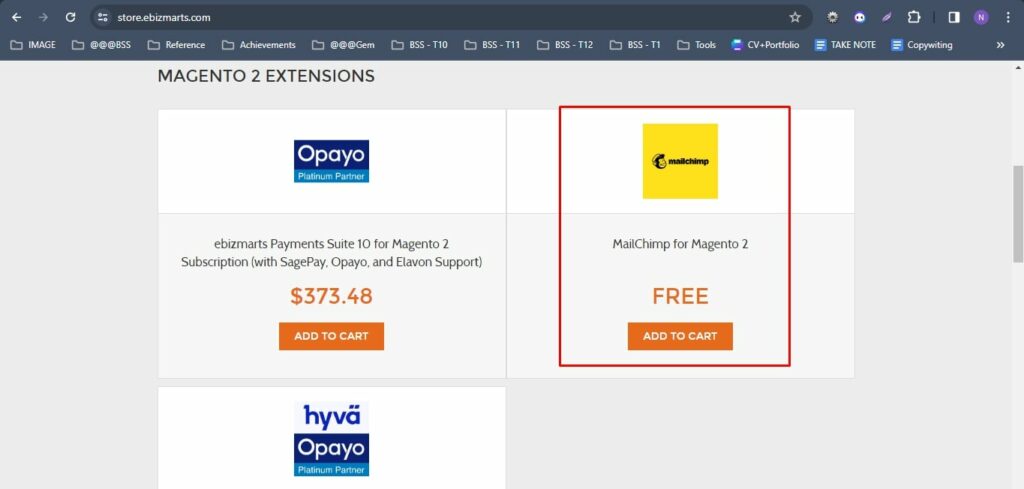
To access the free Mailchimp for Magento file extension, please follow these steps:
1. Go to the Mailchimp for Magento page.
2. Enter your Magento URL.
3. Select your version of Magento from the Magento version drop-down menu.
4. Click on “Add to Cart”.
5. Proceed to Checkout.
6. Enter your ebizmarts account login credentials and click on “Login”.
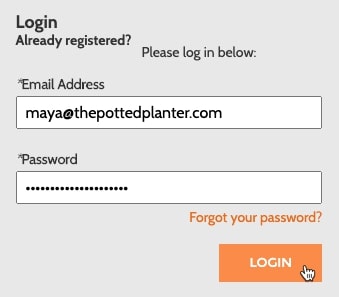
7. Provide your billing and payment information and click on “Continue”. Please note that you will not be charged any fees
8. Finally, click on “Place Order”.
You will receive an order confirmation email containing a download link. Once the file is downloaded to your computer, you can proceed with the installation of Mailchimp for Magento.
Step 2. Set up Mailchimp Integration for Your Magento Store
To set up Mailchimp for Magento, you will need to upload the files from the ZIP folder to the root directory of your Magento store and then clear the Magento cache.
Paste files into folders
Please consult the provided table to determine the appropriate location for placing the ZIP download files in your Magento root directory.
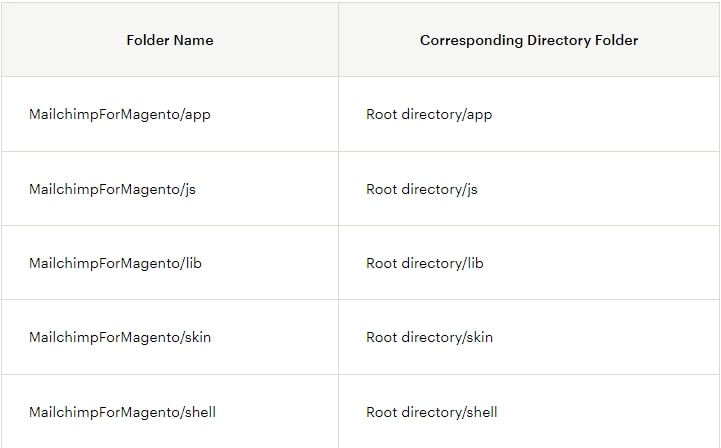
Once you have completed the update to the root directory, remember to flush the Magento cache.
Flush Magento Cache
To flush your Magento Cache:
1. Access your Magento Admin Panel and navigate to the System menu. And then select Cache Management.
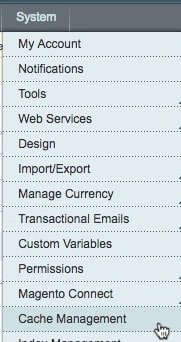
2. Locate the option to Flush Magento Cache and click on it.
![]()
You’re now one step closer to completing the process. Next, you’ll need to configure your Mailchimp for Magento settings.
Step 3. Configure and connect
You need to set up your Mailchimp for Magento settings, specifying how and where you want your customers to be synchronized with Mailchimp. You have the option to either establish a default configuration or customize the settings for each individual store.
To successfully configure and establish a connection with Mailchimp, please follow these steps.
To configure Mailchimp in your Magento Admin Panel, follow these steps:
1. Go to the System menu and select Configuration
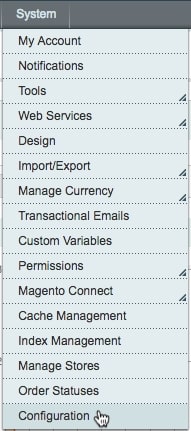
2. In the left navigation pane, click on Mailchimp Configuration

3. Keep the form fields empty for now and click on Get API credentials
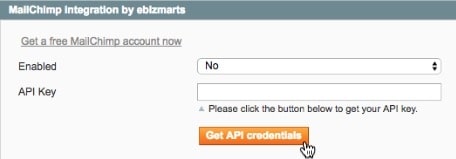
4. A pop-up window will appear. Insert your Mailchimp login credentials, then select Log In”
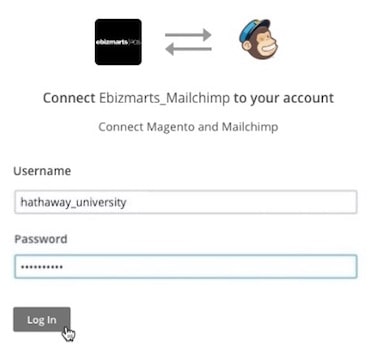
5. In the pop-up window, highlight and copy the API key. You can paste it into a text editor or your clipboard for later use in Magento
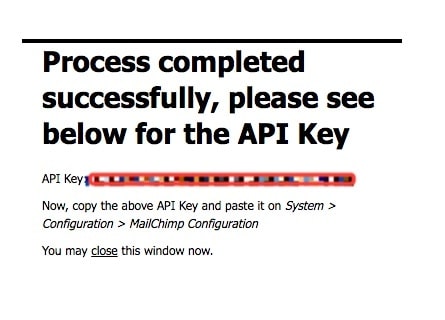
6. Close the pop-up window to return to the configuration screen
7. Paste your Mailchimp API key into the API Key field
8. Click Save Config
9. Once the page reloads, select the desired Mailchimp audience from the General Subscription drop-down menu to sync with Magento

10. If needed, you can edit or create merge fields to send specific information from Magento to Mailchimp
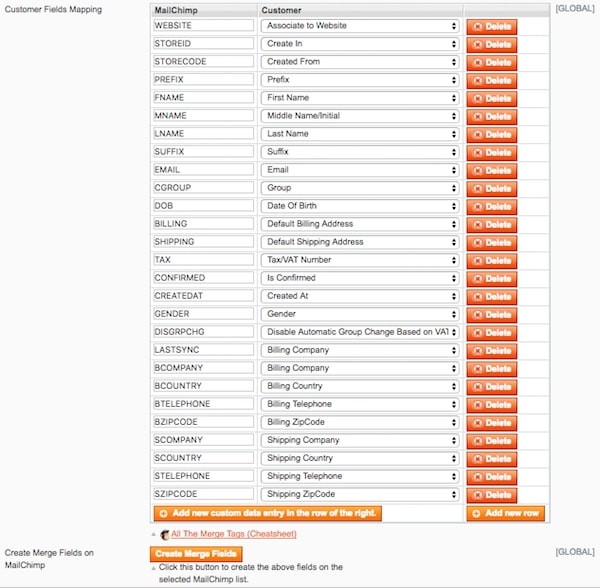
11. In the Ecommerce section, choose Yes from the drop-down menu next to Enabled to enable Mailchimp’s eCommerce features

12. For a permission-based audience, select No from the drop-down menu next to Subscribe all customers to the newsletter. This is the recommended setting
13. To enable Mailchimp’s abandoned cart automation feature, click Yes in the Abandoned Cart section

14. Choose the desired date to begin targeting abandoned carts in the First date field of the Abandoned Cart section
15. Click Save Config
16. And finally, to complete the Mailchimp integration with Magento 2, you will need to set up cron job tasks. If you require
assistance, please reach out to your developer or Magento expert.
So, the Magento 2 Mailchimp integration has been established. Your Magento customers will now be included in your Mailchimp audience, and all eCommerce data will be incorporated into the subscriber profiles in Mailchimp. In addition, guest checkouts will be included in your audience as non-subscribed contacts. To ensure real-time updates, products, customers, and orders will be sent to Mailchimp every five minutes through a cron job.
TAKE NOTE: Magento offers support for multiple websites or store views. In the case of your store having multiple domains, it is possible to connect each domain to its own Mailchimp audience. To make sure a seamless integration, it is recommended to reach out to a Magento developer or consider hiring an expert for professional assistance.
With +11 years of experience, BSS experts can help you perform Magento Mailchimp integration smoothly with our Magento integration services.
Step 4. Optional: Check Out Site Details
To access the details of your site, please follow these instructions:
1. Sign in to your Mailchimp account
2. Locate and click on the Integrations icon
3. Look for the Magento listing and click on it to view the integration details
4. Once you’re on this page, you’ll have the ability to view your synced audience, embed a pop-up signup form on your site, and manage eCommerce automations that utilize data from your connected Magento store.
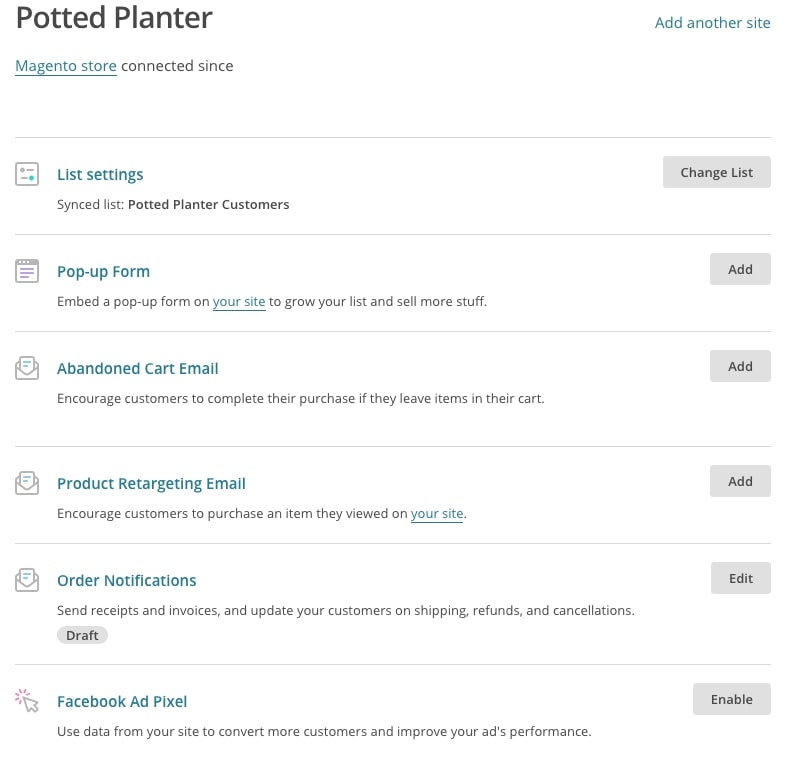
Step 5. Optional: Modify the Synchronized Target Audience
To modify the Mailchimp audience that is synchronized with Magento, you will need to navigate back to your Magento Admin Panel. It is important to keep in mind that if you make changes to your synced audience, the integration will recreate your store in your Mailchimp account, and you will have to recreate any active automations that are linked to your store.
How to update your synced audience:
1. Access your Magento Admin Panel and click on the System menu
2. From the drop-down menu, select Configuration
3. In the left navigation menu, locate the MAILCHIMP section and click on Mailchimp
4. Look for the option labeled Change List and click on it
5. A pop-up window will appear, click on OK
6. Find the General Subscription drop-down menu and select the audience you wish to sync with Magento
7. And finally, click on Save Config to save your changes.
Step 6. Optional: Link to Transactional Email
Here is how to integrate Mailchimp Transactional Email (formerly Mandrill) with your Magento store.
1. Access your Magento Admin Panel and navigate to the System menu. Next, choose Configuration.
2. In the left navigation menu, locate the MAILCHIMP section and click on Mandrill Configuration

3. Expand the configuration options by clicking on the Mandrill Integration by Ebizmarts bar
4. From the Enabled drop-down menu, select Yes to enable the integration
5. Enter a valid Transactional Email API key and choose whether you want to Enable Log
6. Click on the Save Config button
Congratulations! You should now see a success message along with Account Info statistics, including your username, reputation, hourly quota, and backlog.
TAKE NOTE: Once connected, the possibilities for the collected data between both platforms are endless. You can create targeted segments, automate processes, monitor purchases, provide personalized product recommendations, and analyze the outcomes.
Magento Mailchimp Integration: Wrapping Up
To sum up, using one platform for online business may not be enough; you need to integrate with the second platform if you want to maximize its strengths. The Mailchimp Magento 2 integration is a powerful combination that brings together the robust eCommerce capabilities of Magento with the advanced email marketing features of Mailchimp. This integration allows for effective customer segmentation, personalized email campaigns, and detailed performance analysis.
Hope that these guides about Magento Mailchimp integration provided by BSS Commerce Magento are helpful for you. However, if you feel it is quite tough to perform according to these guides, you can totally consider hiring an expert and service provider.
Especially for newcomers in the eCommerce industry, you need to use integration services to prevent errors in the integration process. And finally, don’t forget to visit our BSS Commerce Magento blog to discover the latest posts about Magento integration below:
- Magento integration
- Magento 2 POS integration
- Magento eBay integration
- Magento Hubspot integration
- Magento 2 Amazon integration
